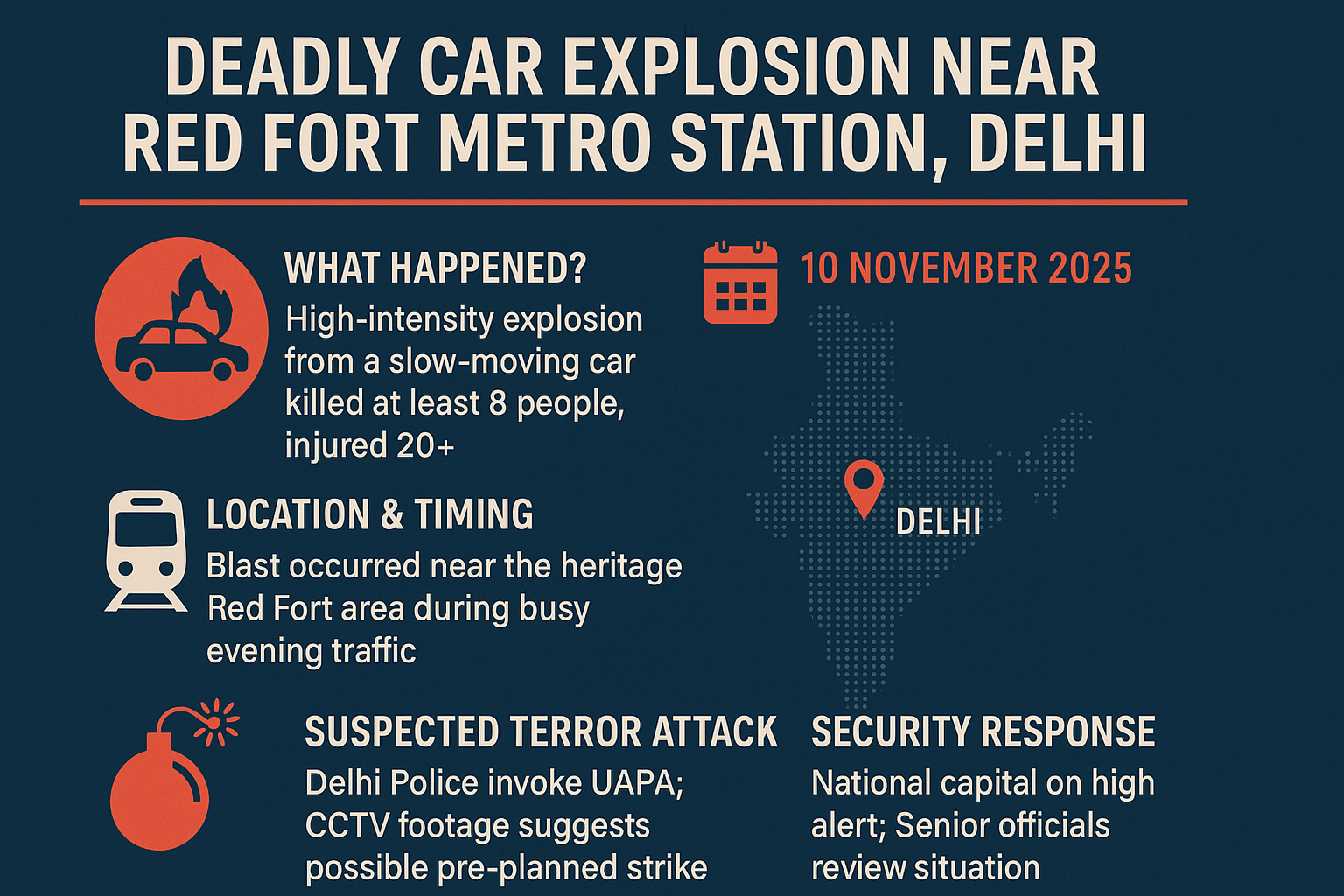Syllabus: GS Paper 3 – Internal Security, Terrorism, Disaster Management
In News Delhi Red Fort Blast

On November 10, 2025, a high-intensity explosion occurred near Red Fort Metro Station, Delhi, killing at least 13 people and injuring over 25 others.
Investigations now point to a “fidayeen-style” terror attack — a deliberate suicide bombing executed using an explosive-laden car near the heritage Red Fort area, one of India’s most iconic and heavily secured zones.
Authorities have invoked the Unlawful Activities (Prevention) Act (UAPA), confirming it as a terrorist strike, not an accident.
What Happened Delhi Red Fort Blast ?
- The explosion occurred around 6:50 PM, when a white Hyundai i20 exploded near Gate No. 1 of Red Fort, setting multiple vehicles on fire.
- Eyewitnesses reported seeing a driver not attempting to escape, suggesting a possible suicide bombing (fidayeen attack).
- Fire and rescue teams arrived within minutes, but the blast had already caused significant casualties and damage to nearby shops and vehicles.
Location and Timing
- The blast site — Red Fort heritage zone — is one of Delhi’s busiest areas, frequented by tourists and local commuters.
- The timing coincided with peak evening traffic, maximizing potential casualties and media attention — a classic hallmark of fidayeen operations.
Evidence of a Fidayeen Attack
According to Delhi Police and Intelligence Bureau (IB) officials:

- Nature of Explosion:
The intensity and pattern suggest high-grade RDX-based explosives.
Forensic analysis indicates the explosive device was triggered manually, from inside the car. - CCTV Footage:
- Footage shows the car entering and halting near the Metro gate minutes before the blast.
- The driver remained inside, making no attempt to escape, confirming a fidayeen-style detonation.
- Recovered Evidence:
- Fragments of a pressure-triggered detonator, steel ball bearings, and PETN traces found on-site.
- Investigators have also recovered a half-burnt mobile circuit, believed to be the triggering device.
- Possible Terror Module Link:
- The National Investigation Agency (NIA) and Delhi Police Special Cell are probing links to a recent terror module busted in Faridabad, which had stockpiled over 200 kg of explosives.
- Preliminary intelligence suggests the attack was planned by a foreign-backed sleeper cell to coincide with India’s upcoming Republic Day security drills.
Government and Security Response
- Home Minister Amit Shah chaired an emergency high-level meeting with the National Security Advisor (NSA) and Delhi Police Commissioner.
- The entire National Capital Region (NCR) has been placed on high alert.
- NIA, IB, and RAW have formed a joint investigation task force.
- Major cities like Mumbai, Lucknow, and Jaipur have enhanced anti-terror surveillance at public places, metro stations, and airports.
Why This Matters: A Shift Toward Urban Fidayeen Operations

The Red Fort attack signifies a strategic escalation in terror tactics:
| Aspect | Traditional Attack | Fidayeen-Style Attack |
|---|---|---|
| Nature | Remote-triggered explosives | Suicide explosion from within |
| Objective | Damage property, cause fear | Inflict maximum symbolic and human loss |
| Tactical Goal | Limited attention | Media spectacle, global impact |
| Implication for India | Urban vulnerability | High-risk of copycat urban strikes |
This reflects a worrying trend: fidayeen tactics migrating from J&K to metro cities — a shift that demands upgraded urban counter-terror strategy.
Broader Implications
1. Security Policy and Intelligence Coordination
- Reveals gaps in urban surveillance, especially in heritage zones.
- Reinforces need for real-time intelligence integration between Delhi Police, NIA, and IB.
2. Urban Counter-Terror Preparedness
- Calls for comprehensive vehicle scanning systems and AI-based threat detection near high-value landmarks.
- Requires updating city emergency drills and public response protocols.
3. Psychological and Symbolic Impact
- Red Fort, being the site of India’s Independence Day address, carries immense national symbolism.
- Targeting it sends a message of defiance — hence, strategic communication and public assurance are crucial.
Global Reactions
- UN Secretary-General condemned the blast, calling it a cowardly act targeting civilians.
- Neighboring nations, including Bangladesh and Nepal, expressed solidarity with India.
- Western intelligence partners have reportedly shared inputs on possible cross-border handlers linked to the operation.
Conclusion
The Delhi Red Fort fidayeen attack marks a new chapter in urban terrorism in India — blending symbolic targeting, suicide tactics, and high visibility.
As the nation mourns the victims, the priority now lies in:
- Strengthening intelligence networks,
- Deploying smart surveillance infrastructure, and
- Ensuring swift justice through inter-agency coordination.
India’s counter-terror architecture must evolve to confront new-age asymmetric threats that challenge not just security, but national morale.
Daily Mains Practice Questions (UPSC GS-3)
- Discuss the implications of the recent Delhi Red Fort fidayeen attack for India’s internal security architecture.
(250 words) - What policy reforms are needed to strengthen India’s urban counter-terror preparedness? Illustrate with recent examples.
(250 words) - Examine the challenges posed by suicide-based terror operations (“fidayeen attacks”) and their impact on national morale and policy response.
(250 words)
Also Read: Extreme Cold Expected in India: Understanding the “La Niña




